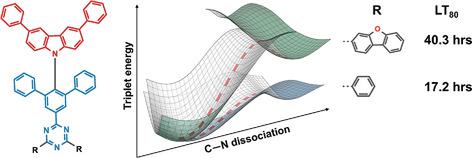当前位置:
X-MOL 学术
›
Adv. Opt. Mater.
›
论文详情
Our official English website, www.x-mol.net, welcomes your
feedback! (Note: you will need to create a separate account there.)
Designing Stable Deep-Blue Thermally Activated Delayed Fluorescence Emitters through Controlling the Intrinsic Stability of Triplet Excitons
Advanced Optical Materials ( IF 8.0 ) Pub Date : 2022-03-18 , DOI: 10.1002/adom.202102309 Hosuk Kang 1, 2 , Soo‐Ghang Ihn 1 , Inkoo Kim 3 , Yeon Sook Chung 1 , Soon Ok Jeon 1 , Myungsun Sim 1 , Joonghyuk Kim 1 , Hasup Lee 1 , Youngmok Son 1 , Won‐Joon Son 3 , Inkook Jang 3 , Dae Sin Kim 3 , Hyeonho Choi 1 , Jin Pyo Hong 2
Advanced Optical Materials ( IF 8.0 ) Pub Date : 2022-03-18 , DOI: 10.1002/adom.202102309 Hosuk Kang 1, 2 , Soo‐Ghang Ihn 1 , Inkoo Kim 3 , Yeon Sook Chung 1 , Soon Ok Jeon 1 , Myungsun Sim 1 , Joonghyuk Kim 1 , Hasup Lee 1 , Youngmok Son 1 , Won‐Joon Son 3 , Inkook Jang 3 , Dae Sin Kim 3 , Hyeonho Choi 1 , Jin Pyo Hong 2
Affiliation

|
Thermally activated delayed fluorescence (TADF) has emerged as a promising and pragmatic light-generation method for producing efficient organic light-emitting diodes (OLEDs). However, the low operational stability associated with blue-light TADF emitters is a major drawback and the excited-state molecular degradation process remains poorly understood. Archetypal TADF emitters are comprised of cycloamine donor and aromatic acceptor moieties, with the corresponding C–N bond considered as the weakest link in the molecular structure. Understanding mechanism of the C–N dissociation in the excited state is, thus, crucial to the engineering of more stable OLEDs. Here, by using a carbazole donor and a triazine acceptor with various functional groups, it is shown that the position of the triplet exciton is the key to enhancing operational stability and, therefore, device lifetime. Interestingly, repositioning the triplet exciton away from the C–N bond causes the dissociation pathway to diverge from a smooth transition state to a more abrupt conical intersection with a higher energy barrier. We realize a 2.3-fold increase in device lifetime without compromising traditional design factors, such as the singlet–triplet energy gap, with judicious introduction of functional groups to the acceptor.
中文翻译:

通过控制三重态激子的本征稳定性设计稳定的深蓝热激活延迟荧光发射器
热激活延迟荧光 (TADF) 已成为一种用于生产高效有机发光二极管 (OLED) 的有前途且实用的发光方法。然而,与蓝光 TADF 发射器相关的低操作稳定性是一个主要缺点,并且激发态分子降解过程仍然知之甚少。原型 TADF 发射体由环胺供体和芳族受体部分组成,相应的 C-N 键被认为是分子结构中最薄弱的环节。因此,了解激发态 C-N 解离的机制对于设计更稳定的 OLED 至关重要。在这里,通过使用具有各种官能团的咔唑供体和三嗪受体,表明三重态激子的位置是提高操作稳定性的关键,并且,因此,设备寿命。有趣的是,将三重态激子重新定位远离 C-N 键会导致解离路径从平滑过渡态发散到具有更高能垒的更突然的锥形交叉点。我们实现了 2.3 倍的器件寿命增加,而不会影响传统的设计因素,例如单重态-三重态能隙,并明智地将官能团引入受体。
更新日期:2022-03-18
中文翻译:

通过控制三重态激子的本征稳定性设计稳定的深蓝热激活延迟荧光发射器
热激活延迟荧光 (TADF) 已成为一种用于生产高效有机发光二极管 (OLED) 的有前途且实用的发光方法。然而,与蓝光 TADF 发射器相关的低操作稳定性是一个主要缺点,并且激发态分子降解过程仍然知之甚少。原型 TADF 发射体由环胺供体和芳族受体部分组成,相应的 C-N 键被认为是分子结构中最薄弱的环节。因此,了解激发态 C-N 解离的机制对于设计更稳定的 OLED 至关重要。在这里,通过使用具有各种官能团的咔唑供体和三嗪受体,表明三重态激子的位置是提高操作稳定性的关键,并且,因此,设备寿命。有趣的是,将三重态激子重新定位远离 C-N 键会导致解离路径从平滑过渡态发散到具有更高能垒的更突然的锥形交叉点。我们实现了 2.3 倍的器件寿命增加,而不会影响传统的设计因素,例如单重态-三重态能隙,并明智地将官能团引入受体。

































 京公网安备 11010802027423号
京公网安备 11010802027423号